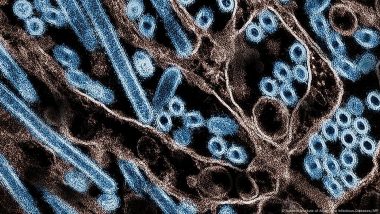A dead body was found, but there are no witnesses, no weapon, no clues. Pathologists are soon hoping to use bacterial colonies found at crime scenes to crack hard cases.Some 800 years ago, mystery gripped a Chinese village when a body was discovered with multiple stab wounds.
Also Read | DRDO Conducts Successful Flight Test of Indigenous Technology Cruise Missile off Odisha Coast (Watch Video).
Upon inspection, local detective Song Ci determined the wounds had been wrought by a sickle. To locate the culprit, he gathered the villagers together on a hot afternoon and told them to lay down their sickles for inspection.
Also Read | Albert Einstein Death Anniversary Date: Know All About the Renowned Physicist and His Groundbreaking Work.
Blowflies started swarming around. They eventually settled on a single sickle. Attracted by trace amounts of the victim's blood, the flies had identified the offender, who was led away pleading for mercy. Case closed.
This is the first known case of a detective identifying a murder suspect by studying insects — a field now known as forensic entomology.
Mark Benecke, a forensic scientist based in Germany, routinely analyzes the life cycles of insects like flies, ants and beetles on dead bodies at crime scenes. As gruesome as it sounds, his work has been instrumental in court cases by helping pinpoint when, and often how, someone died.
In one 2017 case, for example, Benecke determined that an 80-year-old man in Italy had died from neglect by studying the life cycles of flies and ants found in the man's home.
"There are not many forensic entomologists around," Benecke said. But their work can provide the missing link in hard-to-crack cases.
"We can help answer specific questions like: ‘Was the body ever at the edge of a forest, yes or no?'"
Insects at the crime scene
But although bugs can prove helpful under very specific circumstances, Benecke said it's often difficult to collect the right information at the crime scene to provide an analysis useful for a court case.
Insect life cycles are dependent on the surrounding levels of temperature, humidity and light. They are particularly challenging to determine in winter or colder climates when insects are less likely to be around.
Moreover, "often, not enough insects are collected [at the scene] or they are stored badly," Benecke told DW via email. "I was once asked to do a case with a photograph of a photograph of one smashed insect."
FInally, studying the life cycles of insects usually doesn't offer enough precision to determine the exact time of death — crucial information in cases of suspected murder.
Bacteria and fungi may provide a closer look
Enter microbes.
In recent years, scientists have been researching whether analyzing bacteria and fungi could offer an accurate method of pinpointing precise times and causes of death.
In a recent study, researchers appear to have found some support for that hypothesis. They identified a group of microbes that seem to drive the decomposition of bodies, regardless of climate or season.
The study involved analyzing cadavers in different climates of the US during all four seasons. Researchers left the bodies in different locations for 21 days, then analyzed genetic material from tissue samples and created a detailed map of each body's bacterial and fungi populations. Afterward, they entered that data into an AI algorithm which could accurately identify a body's time of death.
The researchers were then able to locate 20 microbes that, like clockwork, appeared on every body they analyzed over the 21-day period.
The joy, at least for pathologists, was that the same microbial species always colonized dead bodies with the same speed, regardless of the location of the body or the climate it was in.
Researchers were also able to pinpoint distinct microbial communities that colonized cadavers in different environments. Some of the microbes that colonized bodies in the desert, for example, were different from those that colonized bodies in forests.
This could allow scientists to tell where a body likely decomposed based on small variations between microbiomes.
Microbes not studied at crime scenes, yet
Studying microbes at crime scenes could aid forensic pathologists in better determining potential suspects and confirming or refuting alibis in suspected murder cases, particularly when the time of death is unclear.
Microbial evidence is guaranteed to be present at the death scene, unlike fingerprints, bloodstains, witnesses, or the gathering of blowflies on a murder weapon.
But forensic scientists aren't using microbes as evidence at crime scenes yet. Benecke said researchers still need more data to understand the many factors that influence their growth.
"It's still at the research stage for the moment. But it's always worth using all the available information [at a crime scene]," he said.
"Mass data and artificial intelligence-powered statistics may allow a good estimation of the post-mortem interval [time passed since death, editor's note], and much more. It's a lot of work though — people need to love the topic, and not many do," Benecke added.
Edited by: Clare Roth
Sources:
Burcham, Z.M., Belk, A.D., McGivern, B.B. et al. A conserved interdomain microbial network underpins cadaver decomposition despite environmental variables. Nat Microbiology. https://doi.org/10.1038/s41564-023-01580-y
(The above story first appeared on LatestLY on Apr 18, 2024 07:30 PM IST. For more news and updates on politics, world, sports, entertainment and lifestyle, log on to our website latestly.com).













 Quickly
Quickly





















